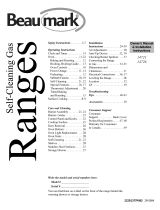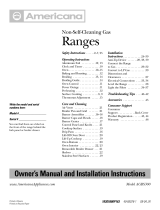
11. CAUTION Do not store items of interest to children in cabinets above an oven-children who
climb onto the oven to reach items could be seriously injured.
12. Never block the vents (air openings) of the range. They provide the air inlets and outlets that are
necessary for the range to operate properly with correct combustion. Air openings are located at the rear of
the cooktop, at the top and bottom of the oven door, and at the bottom of the range.
13. Use only dry pot holders--moist or damp pot holders on hot surfaces may result in burns from steam. Do
not let pot holders touch surface burners, burner grate, or oven heating element. Do not use a towel or other
bulky fabrics in place of pot holders.
14. Do not touch the heating elements or the interior surface of the oven. These surfaces may be hot enough
to burn even though they are dark in color. During and after use, do not touch, or let clothing or other
flammable materials contact any interior area of the oven; allow sufficient time for cooling first. Other
surfaces of the appliance may become hot enough to cause burns. Potentially hot surfaces include the
burners, grates, oven vent opening, surfaces near the opening, crevices around the oven door, metal trim
parts above the door, any back guard, or high shelf surface.
15. Do not heat unopened food containers. Pressure could build up and the container could burst, causing
any injury.
WARNING Extremely Heavy.
Proper equipment and adequate manpower are needed when move the range to avoid personal injury or damage
to the unit or the floor.
Failure to follow this advice may result in damage or personal injury.
8. Be sure all packing materials are removed from the range before operating to prevent ignition of these
materials.
9. Avoid scratching or impacting glass displays. Doing so may lead to glass breakage. Do not cook on a
product with broken glass. Shock, fire, or cuts may occur.
10. Do not leave children alone or unattended in an area where an appliance is in use. They should never be
allowed to climb, sit or stand on any part of the rang
e.
6
3. Any adjustment and service should be performed only by a qualified gas range installer or service
technician. Do not attempt to repair or replace any part of your range unless it is specifically recommended
in this manual.
4. Your range is shipped from the factory set for use with natural gas or propane (LP) gas. It can be
converted for use with either. If required, these adjustments must be made by a qualified technician in
accordance with the installation instructions and local codes. The agency performing this work assumes
responsibility for the conversion.
5. Have the installer show you the location of the range gas shut-off valve and how to turn it off if necessary.
6. Plug your range into a 120-volt grounded outlet only. Do not removed the round grounding prong from the
plug. If in doubt about the grounding of the home electrical system, it is your responsibility and obligation to
have an ungrounded outlet in accordance with the National Electrical Code. Do not use an extension code
with this range.
7. Before performing any service, unplug the range or disconnect the power supply at the household
distribution panel by removing the fuse or switching off the circuit breaker.






















